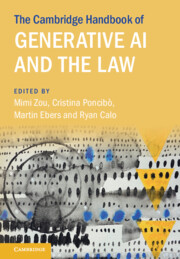Book contents
- The Cambridge Handbook of Generative AI and the Law
- The Cambridge Handbook of Generative AI and the Law
- Copyright page
- Contents
- Figures
- Tables
- List of Contributors
- Foreword
- Preface
- Part I Understanding Generative AI from Multidisciplinary Perspectives
- Part II Evolving Regulatory and Governance Frameworks
- Part III Generative AI
- 14 Generative AI and Non-discrimination Law in the EU
- 15 Generative AI and Data Protection
- 16 Generative AI and the Fundamental Limitations of US Privacy Law
- 17 Generative AI and IP Under US Law
- 18 Copyright and Generative AI in Japan and China
- 19 Redefining Rivalry
- 20 Regulating Hypersuasion
- 21 Generative AI Systems and Corporate Governance, Compliance and Liability
- 22 Generative AI and Criminal Guilt
- Part IV The Use of Generative AI in Legal and Related Sectors
14 - Generative AI and Non-discrimination Law in the EU
from Part III - Generative AI
Published online by Cambridge University Press: 08 August 2025
- The Cambridge Handbook of Generative AI and the Law
- The Cambridge Handbook of Generative AI and the Law
- Copyright page
- Contents
- Figures
- Tables
- List of Contributors
- Foreword
- Preface
- Part I Understanding Generative AI from Multidisciplinary Perspectives
- Part II Evolving Regulatory and Governance Frameworks
- Part III Generative AI
- 14 Generative AI and Non-discrimination Law in the EU
- 15 Generative AI and Data Protection
- 16 Generative AI and the Fundamental Limitations of US Privacy Law
- 17 Generative AI and IP Under US Law
- 18 Copyright and Generative AI in Japan and China
- 19 Redefining Rivalry
- 20 Regulating Hypersuasion
- 21 Generative AI Systems and Corporate Governance, Compliance and Liability
- 22 Generative AI and Criminal Guilt
- Part IV The Use of Generative AI in Legal and Related Sectors
Summary
The AI Act contains some specific provisions dealing with the possible use of artificial intelligence for discriminatory purposes or in discriminatory ways, in the context of the European Union. The AI Act also regulates generative AI models. However, these two respective sets of rules have little in common: provisions concerning non-discrimination tend not to cover generative AI, and generative AI rules tend not to cover discrimination. Based on this analysis, the Chapter considers what is currently the Eu legal framework on discriminatory output of generative AI models, and concludes that those expressions that are already prohibited by anti-discrimination law certainly remain prohibited after the approval of the AI Act, while discriminatory content that is not covered by Eu non-discrimination legislation will remain lawful. For the moment, the AI Act has not brought any particularly relevant innovation on this specific matter, but the picture might change in the future.
Keywords
Information
- Type
- Chapter
- Information
- The Cambridge Handbook of Generative AI and the Law , pp. 221 - 236Publisher: Cambridge University PressPrint publication year: 2025
